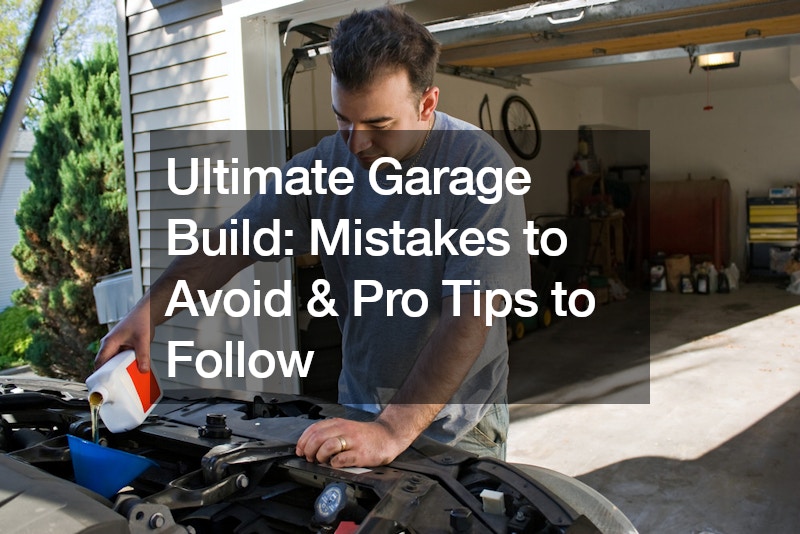
Building your dream garage can be an exciting endeavor, but it also comes with its fair share of challenges and potential pitfalls. Whether you’re planning to create a workshop, storage space, or a haven for your prized vehicles, there are several key considerations to keep in mind to ensure a successful project. In this comprehensive guide, we’ll explore some common mistakes to avoid and share professional tips to help you achieve the ultimate garage build.
1. Foundation and Drainage:
One of the most critical aspects of any garage build is the foundation and drainage system. Poor drainage can lead to water infiltration, damage to your belongings, and structural issues down the line.
Ensure proper grading around the perimeter of your garage to direct water away from the building. Additionally, consider installing a drainage system to prevent water buildup during heavy rains or snowmelt.
2. Material Selection:
Choosing the right materials for your garage build is essential for longevity and durability. Opting for subpar materials can compromise the structural integrity and longevity of your garage.
While steel may offer strength and resistance to rot and pests, it can be challenging to work with, especially when installing electrical components or hanging shelves. Wood, on the other hand, provides versatility and ease of installation but may require more maintenance over time. Consider your specific needs and preferences when selecting materials for your project.
3. Electrical Planning:
Proper electrical planning is crucial for a functional and safe garage space. Underestimating your electrical needs or attempting DIY wiring without proper knowledge can result in safety hazards and code violations.
Ensure you have an adequate number of outlets strategically placed throughout the garage for power tools, lighting, and other electrical devices. Consider hiring a professional electrician to handle the wiring and installation to ensure compliance with local building codes and safety standards.
4. Door Choices:
The choice of garage doors can significantly impact the functionality and convenience of your space. Refusing to invest in quality doors or opting for manual operation can lead to inconvenience, security risks, and increased maintenance needs.
Roll-up doors may offer convenience but can be prone to mechanical issues and may require regular maintenance. Consider investing in quality doors with automatic openers for ease of use and added security. Additionally, weatherproofing and insulation around the door frames are essential to prevent drafts and energy loss. Make sure to prioritize these factors to ensure a seamless garage door installation process and long-term satisfaction with your choice of doors.
5. Insulation and Climate Control:
Proper insulation is essential for maintaining a comfortable and energy-efficient garage environment. Overlooking insulation or choosing inadequate insulation materials can result in temperature extremes, energy loss, and discomfort.
Whether you live in a cold climate or a hot one, insulating your garage walls and ceiling can help regulate temperature extremes and reduce heating and cooling costs. Closed-cell foam insulation is an excellent choice for its superior thermal performance and moisture resistance.
6. Lighting Design:
A well-lit garage is essential for safety and productivity. Inadequate or poorly planned lighting can create safety hazards and hinder your ability to work effectively in the garage.
To illuminate your space effectively, incorporate a combination of overhead lighting, task lighting, and natural light sources. LED lighting fixtures are energy-efficient and provide bright, consistent light for working on projects or performing maintenance tasks. Meanwhile, motion-activated lights can enhance security and convenience.
7. Space Optimization:
Maximizing space efficiency is key to making the most of your garage build. Failing to plan for storage and traffic flow can result in a cluttered and inefficient workspace.
Consider factors such as ceiling height, storage options, and traffic flow when planning the layout. Utilize vertical storage solutions such as shelving, cabinets, and overhead racks to keep clutter off the floor and create a more organized workspace. Customizable modular storage systems offer flexibility and adaptability to suit your changing needs over time.
8. Exterior Considerations:
Don’t forget about the exterior aesthetics and functionality of your garage. Neglecting exterior features such as gutters and downspouts can lead to water damage and erosion around the foundation.
Incorporate features such as gutters and downspouts to manage rainwater runoff and prevent erosion around the foundation. Consider landscaping around the perimeter to enhance curb appeal and create a welcoming entrance to your garage.
The Bottom Line
Building the ultimate garage requires careful planning, attention to detail, and adherence to best practices. By avoiding common mistakes and following professional tips, you can create a functional, durable, and aesthetically pleasing space that enhances your home and meets your unique needs. Whether you’re a seasoned DIY enthusiast or taking on your first construction project, the keys to success are thorough preparation and thoughtful execution.
.

